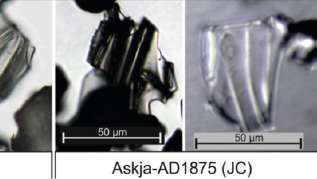Laboratory for Tephrochronology
Contact:
Web:
Infrastructure belongs to:
Tephra, the Greek word for ash, is used to describe any material that is ejected by a volcano into the atmosphere (pyroclasts). Tephra includes dense blocks and bombs (> 64 mm), and lighter materials such as scoria, pumice and ash (< 2 mm). As one moves away from a volcano, the tephra deposits become finer grained (smaller particles) and thinner. This is because small airborne particles hover longer and stay within the atmosphere for a greater distance from the volcano. These particles of ash can be carried in the atmosphere for thousands of kilometers. The smallest particles are so-called crypto-tephra and are invisible to the naked eye.
In the laboratory for tephra analytics, samples taken from lake sediment cores are prepared for the identification and geochemical analysis of individual cryptotephras (glass shards). Identified cryptotephras are a prerequisite for the creation of a tephrochronology that allows the independent dating of our paleoclimate and environmental archives.
Categories
Disciplinary Keywords
Selected infrastructures
Instrumentation
Laboratory instrumentation
Instruments
-
Binocular
A pair of identical or mirror-symmetrical telescopes mounted side-by-side and aligned to point accurately in the same direction, allowing the viewer to use both eyes (binocular vision) when viewing distant objects. Most are sized to be held using both hands, although sizes vary widely from opera glasses to large pedestal mounted military models. (Source: Global Change Master Directory (GCMD). 2023. GCMD Keywords, Version 16.3. Greenbelt, MD: Earth Science Data and Information System, Earth Science Projects pision, Goddard Space Flight Center (GSFC) National Aeronautics and Space Administration (NASA). URL (GCMD Keyword Forum Page): https://forum.earthdata.nasa.gov/app.php/tag/GCMD+Keywords)
-
Heavy Liquid Separation Line
-
Shaker
-
Sieve
Links
Key Publication
- Neugebauer, I., Müller, D., Schwab, M. J., Blockley, S., Lane, C. S., Wulf, S., Appelt, O., Brauer, A. (2021): Cryptotephras in the Lateglacial ICDP Dead Sea sediment record and their implications for chronology. - Boreas, 50, 3, 844-861.
- Neugebauer, I., et al. (2017): Implications of S1 tephra findings in Dead Sea and Tayma palaeolake sediments for marine reservoir age estimation and palaeoclimate synchronisation. - Quaternary Science Reviews, 170, 269-275.
Relationships
- is related to
